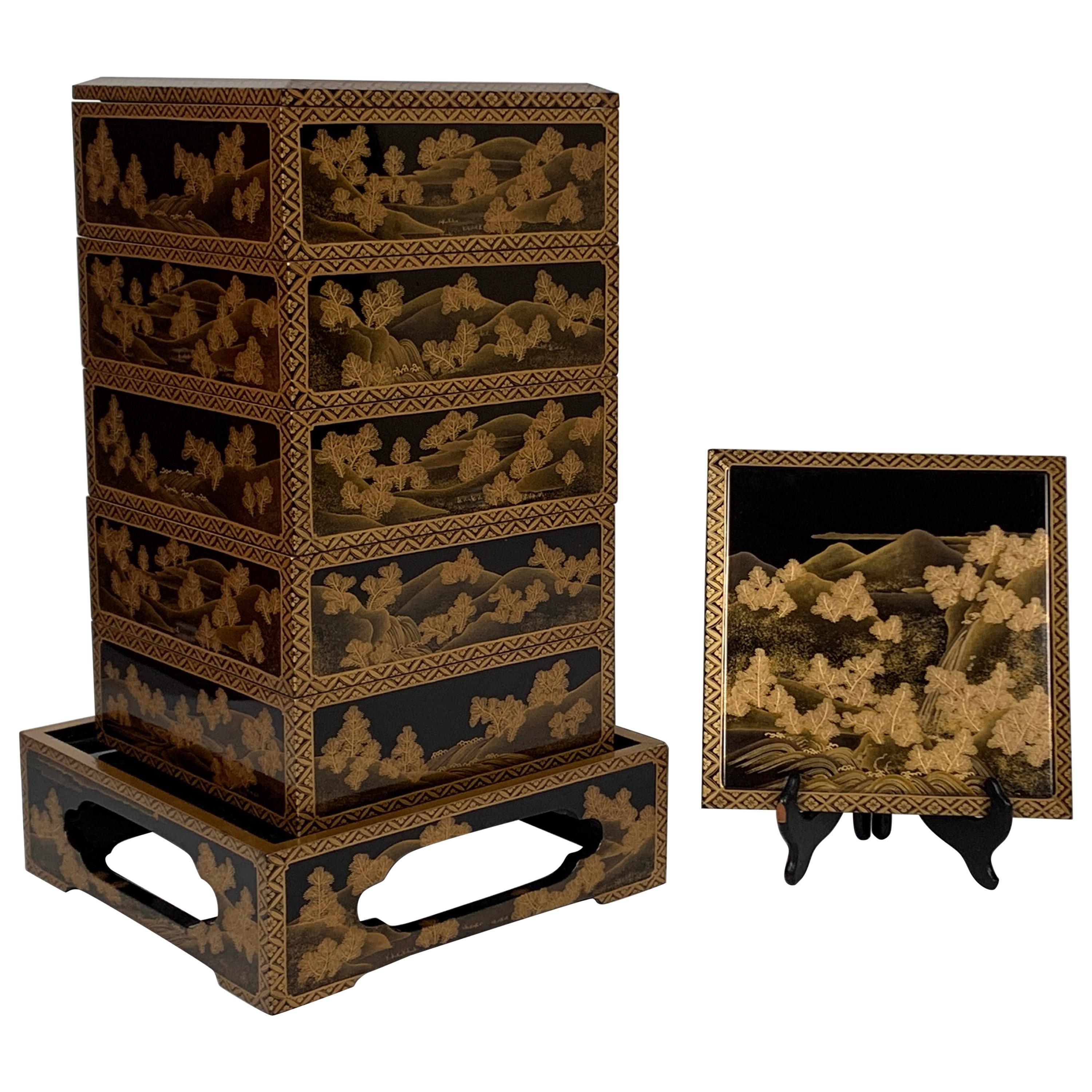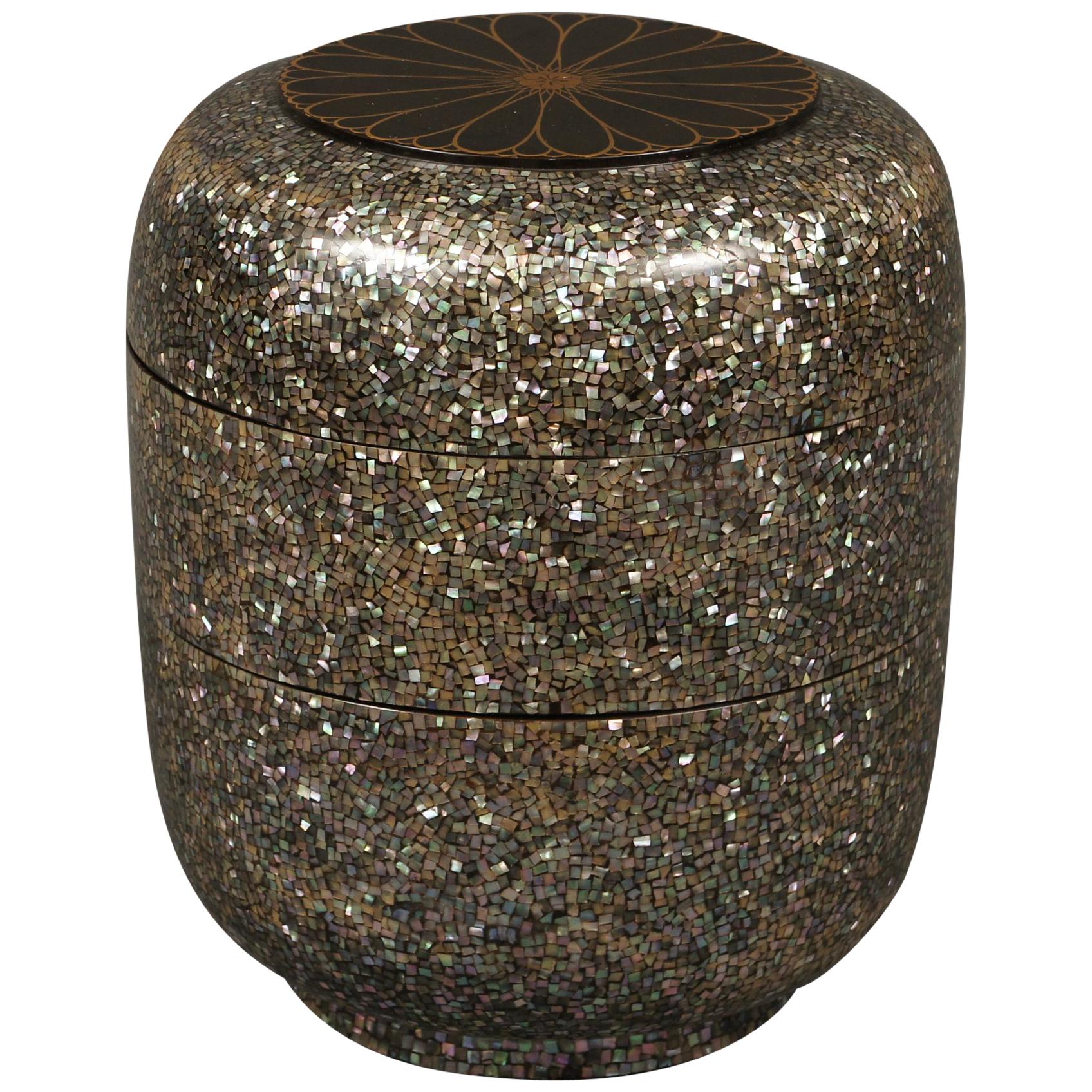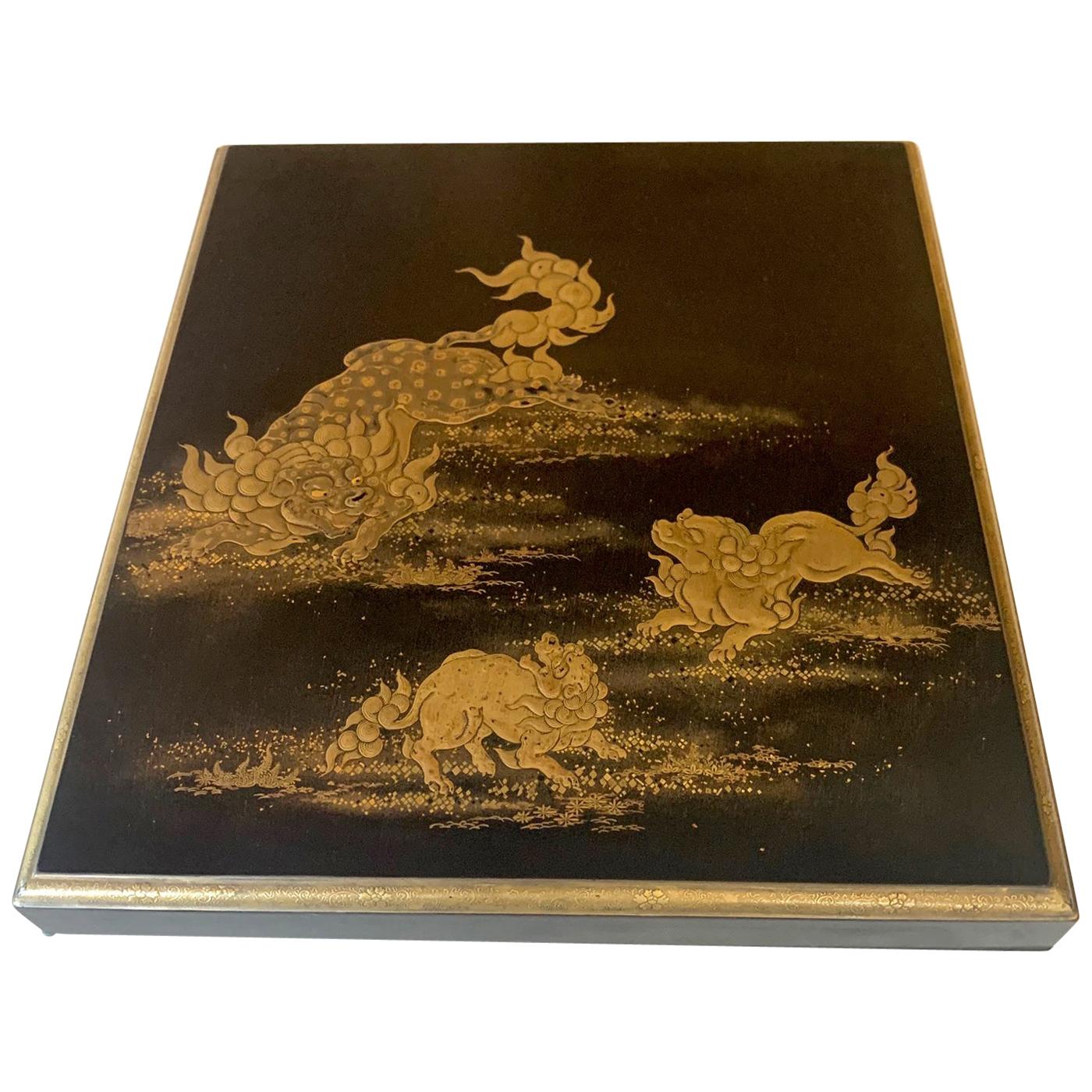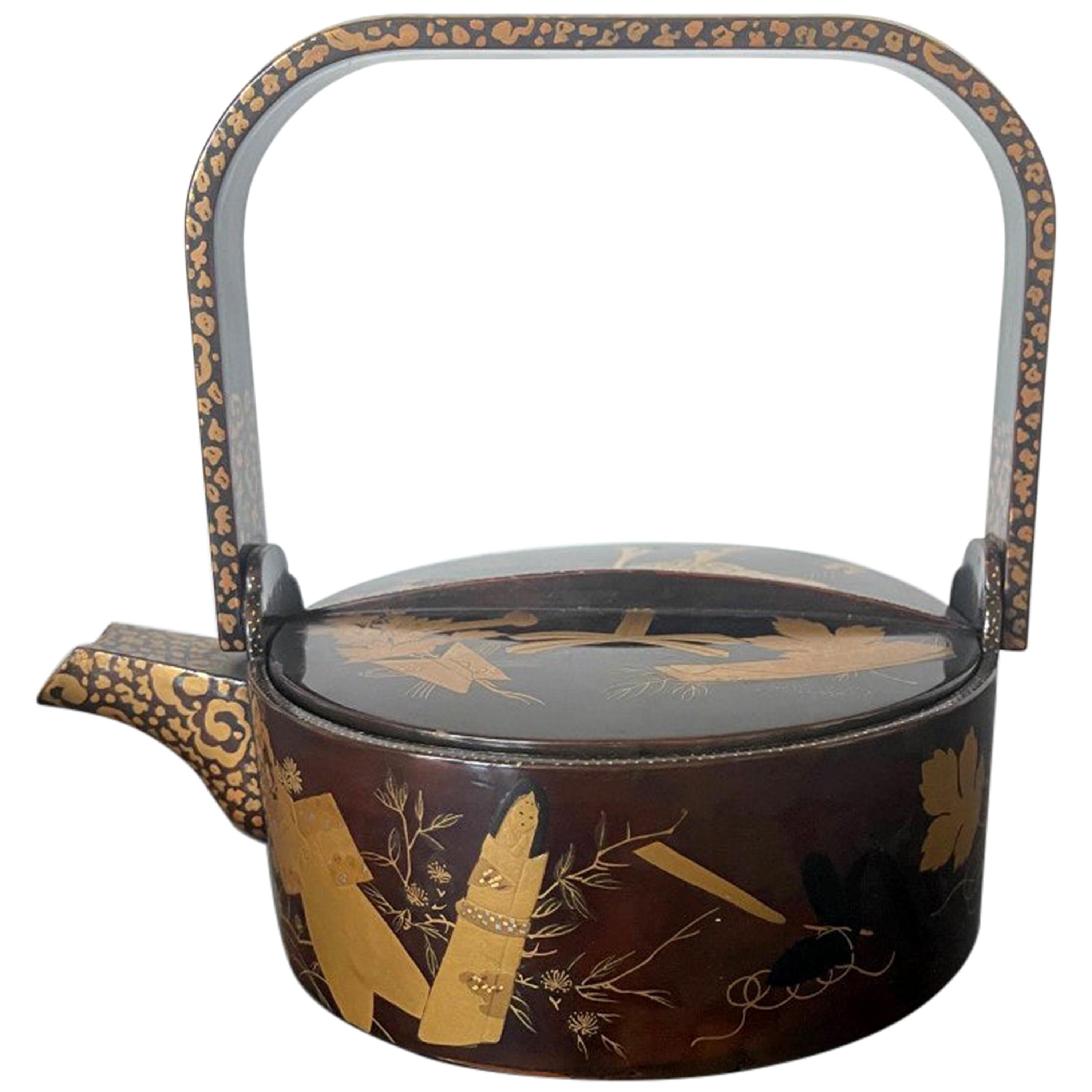Items Similar to Japanese Maki-e Lacquer Stack Box Jubako
Want more images or videos?
Request additional images or videos from the seller
1 of 21
Japanese Maki-e Lacquer Stack Box Jubako
About the Item
An antique jubako (stack boxes) with five tiers in an elongated octagon shape circa 19th century (end of Edo or beginning of Meiji period). jubako was traditionally used to store and carry foods in Edo time, often as part of the accoutrement with a larger set, often for picnics of the wealthy and noble families. The jubako on offer here is decorated with a wide range of exquisite motifs using both hiramakie and takamakie techniques. Two boxes displays floral and leave design on the background of a flowing creek. Two boxes was decorated with fan painting with stunning details of various motifs, on a background of an octagonal turtle back pattern with a four-petal fleur. The top tier features festival tents with flying birds. The top lid showcase a lion (Shishi in Japanese) centered in a floral border. The body of the Shishi was created using Togidashi burnish technique to achieve a dimensional visual effect. The maki-e design was done with extradentary details and mastery. The interior of the box is finished in a vermilion lacquer in keeping with its function as food vessels.
- Dimensions:Height: 11 in (27.94 cm)Width: 7 in (17.78 cm)Depth: 5.8 in (14.74 cm)
- Style:Japonisme (Of the Period)
- Materials and Techniques:
- Place of Origin:
- Period:
- Date of Manufacture:19th Century
- Condition:Wear consistent with age and use. Minor losses. Some small chips and losses along the edges, mostly on the lid as shown. Some stable crack on the corners due to age, general wear and minute losses on surface as expected.
- Seller Location:Atlanta, GA
- Reference Number:1stDibs: LU945022316562
About the Seller
5.0
Platinum Seller
These expertly vetted sellers are 1stDibs' most experienced sellers and are rated highest by our customers.
Established in 2006
1stDibs seller since 2010
479 sales on 1stDibs
Typical response time: <1 hour
- ShippingRetrieving quote...Ships From: Atlanta, GA
- Return PolicyA return for this item may be initiated within 2 days of delivery.
More From This SellerView All
- Japanese Lacquer Box with Fine Maki-e Decoration Meiji PeriodLocated in Atlanta, GAA lacquered wood box with lid from Japan circa 19th century Meiji Period. The finely decorated box was used to store paper slips and small documents on the desk. It is overall finished with black lacquer (kuro) with sparse Mura-Nashiji effect outside and on the top surface of the lid, there are three Komainu, (sometimes known as Shishi or Japanese lions) frolicking and forming a circle in lively motion. Komainu are auspicious animals in Japanese cultures in both Shinto and Buddhism tradition. Originally from China, these animals symbolizes guardians to ward off evil spirits. Hiramaki-e was used in combination with carving and combing to render the lions with various surface textures. A gilt border with an slight angle was given to the lid and even the thin band is decorated with miniature floral scrolls. The interior of the box was finished in a dense nashiji. Underneath the lid, a cluster of peonies open lavishly by two gentle mounts. Takamaki-e (high relief) in both gold and silver were...Category
Antique Late 19th Century Japanese Japonisme Lacquer
MaterialsWood, Lacquer
- Japanese Lacquer Maki-e Sake Ewer Meiji PeriodLocated in Atlanta, GAA Japanese lacquered wood sake ewer with maki-e design, circa late 19th century, Meiji period. The nicely decorated lacquerware is of a Classic sake ewer for...Category
Antique 1890s Japanese Japonisme Lacquer
MaterialsLacquer
- Japanese Lacquer Maki-E Scroll Box Fubako by Kansonsai Edo PeriodLocated in Atlanta, GAA Japanese lacquered wood fubako (a box to store document or small scroll painting) circa late 18th century of Edo period. The rectangular box features a deep lid with rounded corners and recessed mid-edge and a lower box with two bronze medallion rings and tasseled silk ties. The surface of the fubako was elaborately decorated with hiramaki-e and a low takamaki-e on a mottled Mura-nashiji background. The motifs on the lid depict branches of Japanese pine with finely rendered needles on the lower part; on the upper part, it showcases fruited persimmon branches. Two different shades of gold fundame were used to contrast the design and augmented by scattered gold kirigane to highlight some of the leaves. The design continues and cascades down to all sides of the lid as well as the walls of the box. The two bronze medallions appear original to the box and the silk ties show significant fading from the age. This Fine fubako is signed on the lower wall "Kanshosai" in Kanji with a kao mark. All the trims were finished in gold fundame and the interiors a dense nashiji in gold. Kanshosai is the mark of the distinguished lacquer artist Lizuka Toyo I who also signed his work "Toyosai". He was active in the second half of the 18th century during Edo period, employed by Hachisuka Shigeyoshi (1738-1801), daimyo of Awa on Shikoku Island. Although most survived work bearing his marks are inros, he was also known to decorated trays and other larger objects...Category
Antique Late 18th Century Japanese Edo Lacquer
MaterialsWood, Lacquer
- Japanese Antique Lacquer Maki-E Miniature Hasami-Bako with Copper MountsLocated in Atlanta, GAA Japanese lacquered box with lid in the shape of a miniature Hasami-Bako (traveling chest) circa late 18 to early 19th century of the Edo period. The black box is decorated with fin...Category
Antique Early 19th Century Japanese Japonisme Lacquer
MaterialsCopper
- Japanese Maki-e Lacquer Portable Sagejubako Theme of Three Winter FriendsLocated in Atlanta, GASagejubako is a portable lunch or picnic set that became popular in the early Edo period when an additional meal was added between breakfast and dinner. It normally consists of a han...Category
Antique 19th Century Japanese Japonisme Lacquer
MaterialsLacquer
- Japanese Lacquer Maki-E Tiered Suzuribako and RyoshibakoLocated in Atlanta, GAA Japanese roiro lacquer scholar combo box with an upper tier of inkstone box (Suzuribako) and a lower document box (Ryoshibako) circa 1910-30s (end of Meiji to Showa period). The high glossy box was beautifully decorated with an image of the famously eccentric Buddhist monks Hanshan and Shide (known in Japan as Kanzan and Jittoku). Often as a pair, they have been a popular motif in Japanese Zen painting...Category
Vintage 1920s Japanese Meiji Lacquer
MaterialsStone, Metal
You May Also Like
- Japanese Maki-e Lacquer Stacking Box, Jubako, Meiji Period, JapanLocated in Austin, TXA fine and impressive Japanese gold maki-e decorated black lacquer five-tier jubako with presentation tray, two lids, and the original tomobako storage box, Meiji period, late 19th c...Category
Antique Late 19th Century Japanese Meiji Lacquer
MaterialsLacquer
- Antique Japanese Lacquer Stacking Food Box 'Jubako'Located in Hudson, NYWith all-over mother of pearl inlay and mon design of chrysanthemum in gold and black lacquer on top. The chrysanthemum is a national symbol of Japan and the Imperial family.Category
Antique 19th Century Japanese Lacquer
MaterialsGold
- Japanese Meiji Period Antique Lacquer Box with Gold Maki-e DecorationLocated in New York, NYA fine antique Japanese Meji Period lacquer box decorated with a fan and a stylized star shaped window in the maki-e technique. The fan at the top right corner, fully opened depictin...Category
Antique 19th Century Japanese Meiji Lacquer
MaterialsLacquer
- Japanese Black Lacquer Document Box with Gold Maki e Design, Meiji PeriodLocated in Prahran, VictoriaAn antique black lacquer document box with an exquisitely detailed, finely wrought design from The Tale of the Genji depicted in gold maki e across the lid. Internally, the box is de...Category
Early 20th Century Japanese Lacquer
MaterialsWood, Lacquer
- Antique Japanese Lacquer O-Bento Box with Gold and Silver Maki-E DecorationLocated in Prahran, VictoriaAn unusual hexagonally shaped antique Japanese three-tiered o-bento box with a carrying tray decorated with a classical Rimpa style gold and silver Maki-e lacquer design of gently sw...Category
Antique Early 1900s Japanese Meiji Lacquer
MaterialsLacquer, Wood
- Signed Japanese White Lacquer and Maki-E Lacquer Tansu, Meiji PeriodLocated in Ottawa, OntarioThe case decorated overall in crackle-glaze white lacquer and fitted with a patinated metal carrying handle over three tiers of small drawers. The first two tiers are comprised of a ...Category
Antique Late 19th Century Japanese Meiji Lacquer
MaterialsLacquer
Recently Viewed
View AllMore Ways To Browse
Brown Lacquer
Lacquer Brown
Lacquer On Wood
Japan Display
Japanese Interior Furniture
Lacquer Display
Japanese Motif Furniture
Stackable Box
Wood Lacquered Box
Antique Lacquer Boxes
Antique Lacquer Box
Antique Lacquer Asian Furniture
Antique Asian Lacquer
Japanese Wood Box
Japanese Wood Display
Japanese Lacquer Box
Japanese Lacquered Boxes
Lacquered Japanese Box





